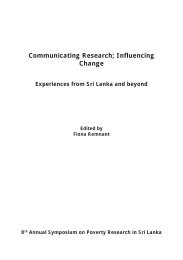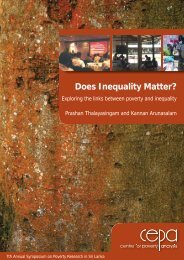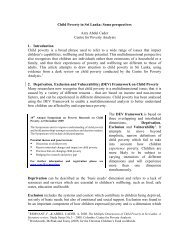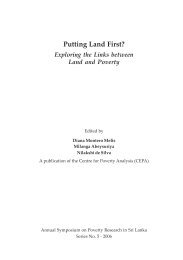- Page 6:
AcknowledgementsOn behalf of the Ce
- Page 9 and 10:
ContentsAcknowledgements...........
- Page 12 and 13:
Common Threads in Resettlement Poli
- Page 14 and 15:
institutions, such as the World Ban
- Page 16 and 17:
high demand in the new, host locati
- Page 18 and 19:
The focus on vulnerability also hig
- Page 20 and 21:
Development projects often create g
- Page 22:
6 ConclusionsThe papers in this vol
- Page 25 and 26:
fõosldjka ;=,oS isÿfõ' CEPA wdh;
- Page 27 and 28:
wj;ekaùfï fya;=j l=ula jqj;a" mqo
- Page 29 and 30:
ixj¾Okh fya;=fjka wj;ekaùfïoS jk
- Page 31 and 32:
n%kaf.a ksÍCIKhg wkqj" ieu wdldrhl
- Page 33 and 34:
5 idOdrK yd iyNd.S;aj l%shdj,Skaby;
- Page 35 and 36:
idOdrK iy iyNd.S;aj hk ,CIK j,ska h
- Page 37 and 38:
tWik Muha;r;rp epiyak; mgptpUj;jpah
- Page 39 and 40:
jk;ik epWtpf; nfhs;Sk; fl;lj;jpw;F
- Page 41 and 42: ,t;tpj;jpahrj;jpy; ,k;%d;W ciufisAk
- Page 43 and 44: kw;nwhd;W Nkhjypd; gpd;du; nrhe;j ,
- Page 47 and 48: xt;nthU gpuptpduplKk; jdpj;jdpahf n
- Page 50 and 51: ,lk;ngau;e;j r%ff; FOf;fspw;fpilapy
- Page 53: Chapter 1:Restoring Livelihoods
- Page 56 and 57: 1 IntroductionThe Southern Transpor
- Page 58 and 59: livelihoods of the affected people
- Page 60 and 61: The RIP also sets out allowances fo
- Page 62 and 63: The replacement of agriculture land
- Page 64 and 65: like tea, rubber and cinnamon have
- Page 66 and 67: Retention of market networks is als
- Page 68 and 69: ReferencesAsian Development Bank. I
- Page 70 and 71: 1 IntroductionCivil conflicts and d
- Page 72 and 73: By overcoming the data collection c
- Page 74 and 75: The above resettler’s income curv
- Page 76 and 77: these IDPs. We do not see the need
- Page 78 and 79: The next category is the Government
- Page 80 and 81: Table 1: Detailed description of an
- Page 82 and 83: of the household did find paid work
- Page 84 and 85: this village suffered a more advers
- Page 86 and 87: Frequency distributions of pre and
- Page 88 and 89: Government Servants who engage in o
- Page 90 and 91: displacement and arriving in Battic
- Page 94 and 95: Chambers, R., and Conway, G.R., 199
- Page 96 and 97: qualitative data collected from foc
- Page 98 and 99: 3.2.1 Sampling plan for the follow-
- Page 100 and 101: The government had to identify land
- Page 102 and 103: Table 5.2: Housing situation of hou
- Page 104 and 105: 5.1.2.1 Quality and durability of t
- Page 106 and 107: Table 5.8: Number of rooms per hous
- Page 108 and 109: electricity has significantly incre
- Page 110 and 111: Although the total fishing fleet ha
- Page 112 and 113: Figure 6.1: Cumulative percentages
- Page 114 and 115: 7 Access to InfrastructureDamage to
- Page 116 and 117: Lack of, or difficult, access to in
- Page 118 and 119: Annex 1: Tsunami affected household
- Page 120 and 121: Ampara 2 Kalmunai Kalmunaikudi 2 6P
- Page 123 and 124: Conflict, Vulnerability and Long-te
- Page 125 and 126: hetoric of displacement and maintai
- Page 127 and 128: The educational performance of IDP
- Page 129 and 130: Most locals did not expect the IDPs
- Page 131 and 132: selected because they represent the
- Page 133 and 134: controversial. People with a certai
- Page 135 and 136: 4 Re-examining VulnerabilityThe stu
- Page 137 and 138: IDPs and Hosts as Constitutive Cate
- Page 139 and 140: local integration processes and the
- Page 141 and 142: 3 From Policy Categories to Labelli
- Page 143 and 144:
The homogenising effect of the labe
- Page 145 and 146:
assist the displaced eased the phas
- Page 147 and 148:
In the case of the northern Muslims
- Page 149 and 150:
people becoming forced migrants; lo
- Page 151 and 152:
A key example is how a joint intere
- Page 153 and 154:
labelled ‘IDPs’ or ‘hosts’.
- Page 155 and 156:
COHEN, R., 2007. Response to Hathaw
- Page 157:
Chapter 3:Ensuring Equitable andPar
- Page 160 and 161:
1 IntroductionWorldwide experience
- Page 162 and 163:
component (HS&CD) of the project, b
- Page 164 and 165:
The LEI&CDP Resettlement Policy Fra
- Page 166 and 167:
(a)(b)(c)those who have formal lega
- Page 168 and 169:
Phase IV - Consolidation, Community
- Page 170 and 171:
Table 1: Resettlement Programme Tar
- Page 172 and 173:
Table 4: Providing infrastructure s
- Page 174 and 175:
8 Issues and conclusionsIssuesAbout
- Page 176 and 177:
ReferencesADB (1995): Involuntary R
- Page 178 and 179:
31 IntroductionThe Southern Transpo
- Page 180 and 181:
The participation and consultation
- Page 182 and 183:
In a majority of cases APs have bee
- Page 184 and 185:
During the implementation of LARC,
- Page 186 and 187:
decision making process has increas
- Page 189 and 190:
Left Behind: Post-tsunami Resettlem
- Page 191 and 192:
To complicate their lives even more
- Page 193 and 194:
visited camps once every eight or n
- Page 195 and 196:
(from 206 to 50 sites) and the shel
- Page 197 and 198:
In October and November 2007, the s
- Page 199 and 200:
nuclear family established through
- Page 201 and 202:
struggle. The joint family, which i
- Page 203 and 204:
camps, although having received com
- Page 205 and 206:
Even though these families were liv
- Page 207 and 208:
Sunil earns a living collecting and
- Page 209 and 210:
Property negotiations are tedious a
- Page 211 and 212:
still remained in transitional shel
- Page 213 and 214:
for government and NGOs alike to be
- Page 215 and 216:
With respect to the transparency of
- Page 217 and 218:
ReferencesABRAMS, P., 1988. Notes o
- Page 219 and 220:
ANNEX9th Annual Symposium on Povert
- Page 221:
EVICTEDThis 25-minute documentary p












